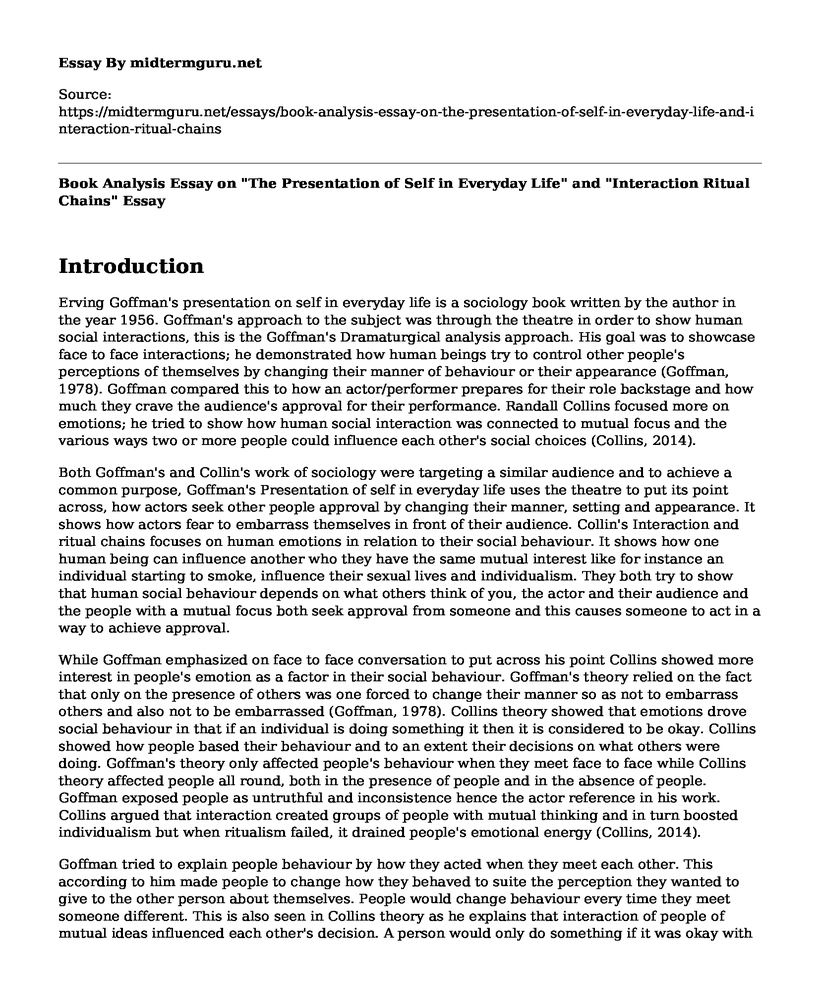Introduction
Erving Goffman's presentation on self in everyday life is a sociology book written by the author in the year 1956. Goffman's approach to the subject was through the theatre in order to show human social interactions, this is the Goffman's Dramaturgical analysis approach. His goal was to showcase face to face interactions; he demonstrated how human beings try to control other people's perceptions of themselves by changing their manner of behaviour or their appearance (Goffman, 1978). Goffman compared this to how an actor/performer prepares for their role backstage and how much they crave the audience's approval for their performance. Randall Collins focused more on emotions; he tried to show how human social interaction was connected to mutual focus and the various ways two or more people could influence each other's social choices (Collins, 2014).
Both Goffman's and Collin's work of sociology were targeting a similar audience and to achieve a common purpose, Goffman's Presentation of self in everyday life uses the theatre to put its point across, how actors seek other people approval by changing their manner, setting and appearance. It shows how actors fear to embarrass themselves in front of their audience. Collin's Interaction and ritual chains focuses on human emotions in relation to their social behaviour. It shows how one human being can influence another who they have the same mutual interest like for instance an individual starting to smoke, influence their sexual lives and individualism. They both try to show that human social behaviour depends on what others think of you, the actor and their audience and the people with a mutual focus both seek approval from someone and this causes someone to act in a way to achieve approval.
While Goffman emphasized on face to face conversation to put across his point Collins showed more interest in people's emotion as a factor in their social behaviour. Goffman's theory relied on the fact that only on the presence of others was one forced to change their manner so as not to embarrass others and also not to be embarrassed (Goffman, 1978). Collins theory showed that emotions drove social behaviour in that if an individual is doing something it then it is considered to be okay. Collins showed how people based their behaviour and to an extent their decisions on what others were doing. Goffman's theory only affected people's behaviour when they meet face to face while Collins theory affected people all round, both in the presence of people and in the absence of people. Goffman exposed people as untruthful and inconsistence hence the actor reference in his work. Collins argued that interaction created groups of people with mutual thinking and in turn boosted individualism but when ritualism failed, it drained people's emotional energy (Collins, 2014).
Goffman tried to explain people behaviour by how they acted when they meet each other. This according to him made people to change how they behaved to suite the perception they wanted to give to the other person about themselves. People would change behaviour every time they meet someone different. This is also seen in Collins theory as he explains that interaction of people of mutual ideas influenced each other's decision. A person would only do something if it was okay with the other person. This showed peoples need for approval hence changing their behaviour to fit in their society. In both presentation of self in everyday life and Interaction ritual chains, expose the human nature for acceptance among others and their willingness to change who they are so as to be accepted in the society.
References
Goffman, E. (1978). The presentation of self in everyday life (p. 56). London: Harmondsworth.
Collins, R. (2014). Interaction ritual chains (Vol. 62). Princeton university press.
Cite this page
Book Analysis Essay on "The Presentation of Self in Everyday Life" and "Interaction Ritual Chains". (2023, Jan 09). Retrieved from https://midtermguru.com/essays/book-analysis-essay-on-the-presentation-of-self-in-everyday-life-and-interaction-ritual-chains
If you are the original author of this essay and no longer wish to have it published on the midtermguru.com website, please click below to request its removal:
- The Literary Representation of Reality: The French Lieutenants Woman and Tragedy of Hamlet
- Compare and Contrast Essay on "Things Fall Apart" and "Heart of Darkness"
- Essay Sample on England's First Feminist Mary Astell
- Does Family Only Encompass Blood Relations? - Essay Sample
- Quality of Life in Early Childhood: A Must-Know - Essay Sample
- The Impact of Race and Ethnicity on Sports and Society - Essay Sample
- Communication: Essential for Survival & Its Cultural Influences - Essay Sample







